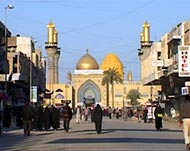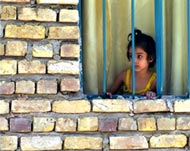Bridge over the river Tigris
In the crowded and winding streets of al-Adhamiya, a 1000-year-old Sunni locality of Baghdad, explosions from mortars and grenades and long volleys of machine gun fire break out every half hour.

US tanks rumble through narrow alleys, helicopters circle and fire on intersections with Gatling guns, and snipers scramble across the rooftops.
Every day and night there is war in this civilian neighbourhood where any given street is the frontline.
On one side is the US military, which has holed up in several spots, including the Royal Tombs where the former kings of Iraq are buried.
On the other are scores of bare-footed, masked Iraqi youth bobbing through alleyways with rocket propelled grenades, some sporting soccer jerseys with the word Iraq emblazoned on the back.
One fighter kneels directly in front of an M1-Abrams tank carrying US soldiers and blasts them with a rocket-propelled grenade. As the tank bursts into flames, the fighters begin to shout: “God is greatest!”
“I wish I could be one of them and defend my country,” says 17-year-old Karrar, watching the battle from a window. “I would be so honoured to join them,” he says.
Ongoing clashes
The sound of gunfire and huge plumes of black smoke rise above the skyline of al-Adhamiya, just on the other side of the river.
Meanwhile, pilgrims mill peacefully in the sun before the gold-plated domes of a sacred shrine in al-Kadhimiya, another 1000-year-old locality of Baghdad.
Al-Adhamiya and al-Kadhimiya, which are linked by a bridge over the river Tigris, are like two sides of one coin – joined, but each with a different face.
Al-Adham means the one who is greatest, and Al-Kadhim means the one who suppresses his anger.
The two neighbourhoods have similar origins but different identities, and at times, it seems, separate destinies.
 |
|
The shrine in al-Kadhimiya |
Both were founded in the eighth century – al-Adhamiya, atop the tomb of al-Imam al-Adham (The greatest Imam), Abu Hanifa al-Numan bin Thabit, the founder of the Hanafi school of Islamic law, one of the main Sunni legal schools of thought.
For centuries, traditionalist Sunnis have sought to live near his tomb, over time creating a community almost exclusively Sunni.
Al-Kadhimiya was founded atop the tomb of Imam Musa al-Kadhim, one of the 12 Imams revered in Shia Islam. For centuries, devoted Shia have gathered to live near his tomb resulting in a nearly exclusively Shia community.
Unlike embattled al-Adhamiya, al-Kadhimiya is relatively quiet and peaceful.
Members of Shia cleric Muqtada al-Sadr’s Mahdi army still roam the streets, but have traded their black and green uniforms for plainclothes attire and concealed their guns.
“We just changed our clothes so the US military won’t know we’re the Mahdi army,” says Arkan Aziz who is one of 1000 armed Iraqis cooperating with the police and legally charged with guarding the shrine.
Different resistance
As a sign of resistance to the occupation, instead of fighting tanks in the streets, al-Kadhimiya residents joined their Sunni countrymen to gather massive amounts of food, blood and medicine for the people of Falluja, where a brutal battle has been raging between US forces and Iraqi fighters for days.
Al-Kadhimiya’s more subdued opposition, and the US military’s reaction to the neighbourhood, provides a striking contrast to its neighbour across the Tigris.
Small clashes broke out in al-Kadhimiya last week, but after the killing of two US soldiers and one Iraqi militia member, US forces apologised and asked for negotiations, according to the local religious leaders.
They promised they would not enter al-Kadhimiya with their tanks and Humvees again, says Shaikh Raid al-Kadhmi a representative of Muqtada al-Sadr’s office.
“The Americans consider themselves the friends of the Shia and they don’t want to lose those friends. But we told them if you are hostile to us again we’ll respond with hostility to you,” said al-Kadhimi.
 |
|
A young Iraqi witnesses the |
While US military personnel were withdrawing from al-Kadhimiya shrine area out of respect for an important Shia shrine, across the river, US tanks were ramming down the gates of al-Adhamiya’s 900-year-old Abu Hanifa mosque.
The tanks drove into the main courtyard, destroying foodstuff gathered for the besieged residents of Falluja.
But residents of al-Kadhimiya bridle at the notion they are not resisting as much as their Sunni countrymen.
Looking forward
“We’re not quiet,” argues Ali al-Dabagh, an official with the Khalis religious school, whose focus is on unity between Sunnis and Shia.
“We’re trying to be with the Sunnis. When the people of al-Kadhimiya welcome the families of Falluja and offer them food and medicine – that is also resistance.
“All of us are resisting- just at different levels. We agree on one thing – the occupation has to end.”
Al-Kadhimiya’s stance is enough for Bashiar Abd Al-Sattar. Shaken and reeling from five days of continuous bombing, she just arrived in al-Adhamiya from Falluja with her four children.
“On the way here we passed through a Shia neighbourhood,” she says, adding, “The whole way, people were lining both sides of the street welcoming us into their homes – our cars could hardly move – they offered us cold water, hot bread, fruits and prepared meals.”
|
“We’re all Muslims, all Mujahidin, and all of us are fighting to kick the Americans out, however long it takes” Ahmad, |
“They chanted – ‘with our souls, with our blood, we sacrifice for you Falluja’ – we cried out of happiness to see them supporting us – because the Americans think we hate each other,” said Abd Al-Sattar.
The current unity between the Sunni in areas like al-Adhamiya and the Shia in places like al-Kadhimiya – where it leads and whether or not it can continue – depends as much on mutual tolerance for different approaches to resistance as it does on the political manoeuvres of US occupation forces.
If the Shia are able to successfully negotiate a withdrawal of occupation forces from their areas, and the Sunnis are not, the potential for division and discord is great.
The question on many minds is will the two groups stay together or go their separate ways?
Back in al-Adhamiya, Ahmad, a local, is driving through the area with his friend Wisam from al-Kadhimiya.
The two are dodging sniper-fire in a car loaded with posters of Shia leader and advocate of armed resistance Muqtada al-Sadr, which they are posting around the neighbourhood.
“Don’t talk about Sunni and Shia anymore,” says Ahmad, adding, “We’re all Muslims, all Mujahidin, and all of us are fighting to kick the Americans out, however long it takes.”